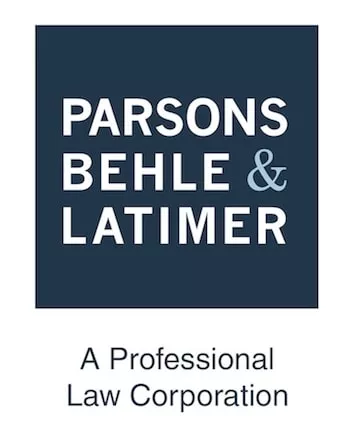As a change of pace for its Employment Law Updates at this festive time of the year, Parsons Behle & Latimer asked one of its employment attorneys to devote his seasoned research and writing skills to analyzing not a workplace issue, but the best loved holiday poem of all time. We share his legal brief below, as a gift of appreciation to our many clients, friends and associates. Happy Holidays and Happy New Year!
'Twas the Night Before Christmas...200 years and counting
By Michael Patrick O'Brien*
I've read and loved "A Visit from St. Nicholas" (aka "The Night Before Christmas") all my life. And to celebrate the poem's publication bicentennial in 2023, I am now enjoying its interesting history, too.
Some say the beloved story—with just over 500 words and 50 lines—contains the best-known verses ever written by an American. That makes sense. I read it almost every Christmas Eve, when my children were young, and I still read it today for myself.
When the Troy Sentinel newspaper first published the poem in December 1823, however, the poet chose to remain anonymous. Author Clement Clarke Moore (1779-1863) did not claim authorship until about 20 years later.
Why?
Apparently, publishing anonymously was a common practice back then. Newspapers were not always respected journals for reputable works.
There are other possible reasons, too. Moore was known as a very stern and serious man, and his family was deeply embedded in New York City's upper crust.
Moore's father was the local Episcopal bishop and the fifth president of Columbia University. He also gave Holy Communion to Alexander Hamilton on Hamilton's deathbed in 1804...but only after the great American founder repented of the sin of dueling.
Moore's mother's family owned a large country estate. Their holdings included the 30 acres of land now known as the Chelsea neighborhood in west Manhattan.
Moore himself was an erudite professor of Greek and Hebrew literature at an Episcopal seminary in New York as well as a wealthy real estate developer. He also served for almost four decades on the board of trustees of Columbia University.
He is said to have written "A Visit from St. Nicholas" on a lark to entertain his children, which it no doubt did. He was so concerned about his literary reputation in scholarly circles, however, that he would not put his name on a mere whimsical children's poem.
This reluctance to accept credit may have helped fuel an ongoing dispute about the poem's authorship. Scholars have published dueling papers debating who actually wrote it, and the New York Times reported the controversy in 2000. The Hallmark Channel joined in with a 2022 movie about a fictional courtroom drama centered on the poem's creation.
Although there may be reasonable doubt about its origins, there's no real argument concerning the poem's long-term impact on the holiday it honors. That may be why today, three of the four surviving hand-written copies of the poem are secured in museums.
Commentators say the poem is primarily responsible for today's notions of Santa Claus and even for how we celebrate Christmas.
A 2021 article in the Columbia University magazine says Moore based his main character on Sinterklaas, the Dutch name for St. Nicholas. On his Dec. 5, feast day, Sinterklaas leaves candy or coal in the wooden shoes of Dutch children.
Moore had a couple influential connections to the old Dutch saint. About a decade earlier, Moore's friend and fellow writer Washington Irving (famous for "The Legend of Sleepy Hollow," another classic for another holiday), authored a book including a St. Nicholas character who flies around in a wagon above the treetops and smokes a pipe with swirling smoke.
Another friend of Moore hosted an 1810 dinner in honor of St. Nicholas. Moore attended. That friend is said to have used the phrase "Santa Claus" there, perhaps the first known spoken Anglicized version of Sinterklass in America.
In Gotham: A History of New York City to 1898 historians Edwin Burrows and Mike Wallace say Moore deliberately chose for his "jolly old elf" to arrive on Christmas Eve rather than Christmas Day. Two centuries ago, high-brow New York families preferred New Year's Day as the family holiday of the season.
Some Protestants viewed Christmas Day festivities as resulting from "Catholic ignorance and deception." Moore "deftly shifted the focus away from Christmas Day with its still-problematic religious associations" and "New Yorkers embraced Moore's child-centered version of Christmas as if they had been doing it all their lives."
The first reference to Santa's sleigh being pulled by a reindeer appears in "Old Santeclaus with Much Delight," an 1821 illustrated children's poem also published in New York. Two years later, Moore added seven more reindeer to the team.
In the original poem, the names of the reindeer are given as Dasher, Dancer, Prancer, Vixen, Comet, Cupid, Dunder and Blixem. In a later version of the poem, Moore also used "Donder" and "Blitzen," which roughly translate in English as "Thunder" and "Lightning."
(Rudolph came along almost a century after Moore died, but that's another story.)
During the Civil War, artist Thomas Nast took Moore's written description of Santa and turned it into the visual images we all cherish today.
In 1866, Nast published a 20-vignette cartoon depicting Santa's Workshop that featured "Moore's elfin, fur-suited Santa standing on a chair to reach the stockings hung on the mantle. To his left, he was using hand tools to make toys in his workshop, while at the lower right, he was hand-sewing dollies' clothes; four other vignettes depicted dollies' kitchen, parlor, tea party and costume assortments. Nast's oldest child Julia was four, so his mind was focused on gifts for her."
Nast called his drawing "Santaclaussville, N.P.," thus giving Santa a North Pole home for the first time. Nast liked that location because it was "geographically isolated, politically neutral and a natural tie-in to reindeer and snow."
Others have added to the classic story over the years, too. My favorite came in 1965, when musician Harry Simeone put it to music. Simeone's arrangement even gave us an epilogue—the night after Christmas—when the presents "are scattered and broken I fear, and St. Nicholas won't come again for a year," and which concludes with that much deserved (but previously denied) parental "long winter's nap."
I must confess to a longstanding bad case of writer's envy for the words and phrases Moore coined. For example, why didn't I think of rhyming "clatter" and "matter"?
There may not be a better description of action in the English language than: "Away to the window I flew like a flash, Tore open the shutters and threw up the sash."
I doubt that anyone could better describe with more endearing charm than what Moore did here: "His eyes—how they twinkled! his dimples, how merry! His cheeks were like roses, his nose like a cherry!"
In fact, I love this work so much that it only seems fair—200 years later—to give Moore the final word in this brief honoring the bicentennial of the great Christmas poem for which he never wanted to be known...
By Clement Clarke Moore
'Twas the night before Christmas, when all through the house
Not a creature was stirring, not even a mouse;
The stockings were hung by the chimney with care,
In hopes that St. Nicholas soon would be there;
The children were nestled all snug in their beds;
While visions of sugar-plums danced in their heads;
And mamma in her 'kerchief, and I in my cap,
Had just settled our brains for a long winter's nap,
When out on the lawn there arose such a clatter,
I sprang from my bed to see what was the matter.
Away to the window I flew like a flash,
Tore open the shutters and threw up the sash.
The moon on the breast of the new-fallen snow,
Gave a lustre of midday to objects below,
When what to my wondering eyes did appear,
But a miniature sleigh and eight tiny rein-deer,
With a little old driver so lively and quick,
I knew in a moment he must be St. Nick.
More rapid than eagles his coursers they came,
And he whistled, and shouted, and called them by name:
"Now, Dasher! now, Dancer! now Prancer and Vixen!
On, Comet! on, Cupid! on, Donner and Blitzen!
To the top of the porch! to the top of the wall!
Now dash away! dash away! dash away all!"
As leaves that before the wild hurricane fly,
When they meet with an obstacle, mount to the sky;
So up to the housetop the coursers they flew
With the sleigh full of toys, and St. Nicholas too—
And then, in a twinkling, I heard on the roof
The prancing and pawing of each little hoof.
As I drew in my head, and was turning around,
Down the chimney St. Nicholas came with a bound.
He was dressed all in fur, from his head to his foot,
And his clothes were all tarnished with ashes and soot;
A bundle of toys he had flung on his back,
And he looked like a pedler just opening his pack.
His eyes—how they twinkled! his dimples, how merry!
His cheeks were like roses, his nose like a cherry!
His droll little mouth was drawn up like a bow,
And the beard on his chin was as white as the snow;
The stump of a pipe he held tight in his teeth,
And the smoke, it encircled his head like a wreath;
He had a broad face and a little round belly
That shook when he laughed, like a bowl full of jelly.
He was chubby and plump, a right jolly old elf,
And I laughed when I saw him, in spite of myself;
A wink of his eye and a twist of his head
Soon gave me to know I had nothing to dread;
He spoke not a word, but went straight to his work,
And filled all the stockings; then turned with a jerk,
And laying his finger aside of his nose,
And giving a nod, up the chimney he rose;
He sprang to his sleigh, to his team gave a whistle,
And away they all flew like the down of a thistle.
But I heard him exclaim, ere he drove out of sight—
"Happy Christmas to all, and to all a good night!"
The content of this article is intended to provide a general guide to the subject matter. Specialist advice should be sought about your specific circumstances.


